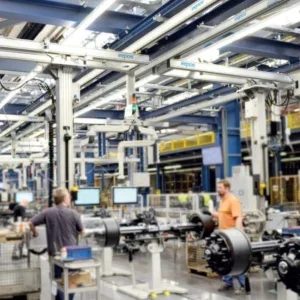Although not a preferred method, there can be technical as well as economic advantages to using a crane and basket. However, care must be exercised in checking the suitability of the crane and the basket for the application and in ensuring the organisational safety measures are adequate. It is a subject which is the source of regular enquiries to the LEEA office; a recent one involved a new crane which was being purchased in the knowledge that it would be used to lift a personnel carrier.
Until recently there hasn’t been a specific standard dealing with this subject, although certain requirements have been established custom and practice. However, in late 2005, European Standard EN 14502-1 was published. The title is ‘Cranes – Equipment for lifting persons – Part 1: suspended baskets’. As well as specifying the requirements for the basket, it includes informative annexes dealing with compatibility with the crane and organisational requirements.
A long established ‘rule of thumb’ is that the crane should have a safe working load of at least twice the total weight of basket, personnel and anything else lifted within the basket such as tools and materials. Equally important is the control system. The controls should be set at ‘hold to run’, so that when released the motion stops automatically. Lowering should always be under power, not by gravity alone. Hydraulic cranes should be fitted with devices to arrest movement in the event of a hose or pipe failure. The acceleration and deceleration of the basket should be smooth and the speed not in excess of 0.5 metres per minute.
The essential requirements for the basket are all sensible but, from the calls received, not always obvious. You would expect it to be ‘long enough and strong enough’ – of a strength and dimensions to suit the application and that includes allowances for equipment. The sides and floor must be protected to prevent people and equipment from falling over or through, by provision of suitable handrails, guard rails and toe boards and keeping any apertures below a maximum size. To avoid crushing hands, the handrails must be positioned well inside the side protection. The floor must be slip resistant and drained. The means of entry and leaving must latch automatically and not open outwards.
In use, people and equipment will be moving within the basket and the design must limit the amount of tip possible. Anchorage points for personal protective equipment are also required and, if used where there might be the hazard of something falling from above, a roof is required. Finally the basket base should be set in from the floor edge to avoid the risk of crushing feet when landing the basket.
The third element of lifting people safely by crane is the organisational requirements. The lifting operation should be properly planned and supervised, as all lifts should be. One appointed person should direct the operation. The crane driver should remain at the controls at all times and there always must be an effective means of communication between the driver and the personnel in the basket.
There must be effective means of controlling the basket, rotating it if required and reducing swing to the minimum. Tag lines can provide a simple solution in many cases. Particular care is necessary to avoid collisions and entrapment when operating close to other equipment, especially if the equipment is moving. If the basket is to be moved through an opening, the risk of crushing must be considered. It is in such operations that communications can fail through loss of visible or audible contact.
The personnel using the basket should be trained in safe work practices. As well as their own safety, care must be taken of other personnel who might be affected, particularly if materials, hand tools and personal property (such as mobile phones) could fall. In critical situations, tools and equipment can be secured by their own lanyards.
Last but not least there must always be a rescue plan in the event that equipment breaks down or, for whatever reason, it becomes impossible to move the basket. The plan must not depend upon the personnel in the basket being able to assist in the rescue.
The introduction in the UK of the Work at Height Regulations 2005 has focused more attention on the issue of access and worker protection. Lifting people with cranes is not something that the LEEA likes to encourage. In the vast majority of cases there are other more suitable methods. However for some jobs it may be the most appropriate approach and, if the necessary care and attention is taken, can be done safely.






